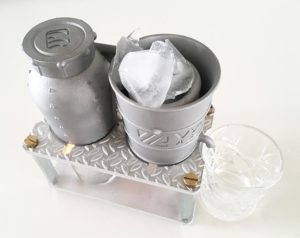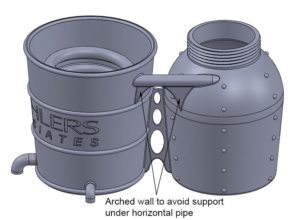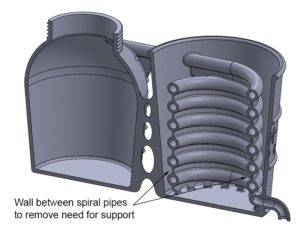 Post-processing. No one wants to talk about it, but everyone working with metal additive manufacturing has to do it. …Right? While Rize is working to remove the pain of post-processing from plastic 3D printing processes, and Desktop Metal has been making headway with easily removable supports on the metals side, as of today there’s no easy answer for the problem of post-processing. It’s time-consuming, it’s messy, it’s expensive, and it can be pretty painful. Prolific designer Olaf Diegel certainly knows this, having bled for these efforts — and so he recently set out to showcase how design can help to work around this particular pain point. To make it even less painful, Diegel set out with a creative bent in mind.
Post-processing. No one wants to talk about it, but everyone working with metal additive manufacturing has to do it. …Right? While Rize is working to remove the pain of post-processing from plastic 3D printing processes, and Desktop Metal has been making headway with easily removable supports on the metals side, as of today there’s no easy answer for the problem of post-processing. It’s time-consuming, it’s messy, it’s expensive, and it can be pretty painful. Prolific designer Olaf Diegel certainly knows this, having bled for these efforts — and so he recently set out to showcase how design can help to work around this particular pain point. To make it even less painful, Diegel set out with a creative bent in mind.
The designer, who we’re largely familiar with through his creative instruments, including an aluminum 3D printed guitar, never shies away from a design challenge. Well-versed in design for additive manufacturing — to the point of teaching a recent course on the topic — Diegel is aware of the benefits and limitations of additive manufacturing. His work as an Associate Consultant with industry knowledge powerhouse Wohlers Associates, as well as a professor of product development at Sweden’s Lund University, speak to the breadth of his experience, and so it should be no surprise that this creative mind was up to a unique challenge recently: “What do you get for the man who has everything?”
“It all started in a conversation at a 3D printing event where I was talking to Torbjörn, the head of Lasertech (a Swedish metal AM company) and we thought it would make for a good metal demo and conversation piece,” Diegel tells 3DPrint.com of his most recent design undertaking.
“And, because over the past couple of years I have been doing more and more metal AM components, and I have had literally bleeding hands from having to remove support material from parts, it has given me a really good understanding of why designing to minimize post-processing is so important. Post-processing is the current Achilles heel of metal AM, because it takes such a lot of time (and therefore money). But, if the parts are designed correctly, this post-processing can be minimized.”
So, what does the man who can design anything make for the man who has everything? The answer is, of course, a desktop still.
Because who doesn’t want their own itty bitty desktop distillery? (Admittedly I didn’t know until this morning that I wanted one, but now I can’t un-know that…)
“It was a fun project because most of the stuff I work are more common engineering projects and, there is nothing at all wrong with that at all, but sometimes it’s nice just to be able to do something a bit more creative. Something that serves no real useful purpose, but is just plain fun!” Diegel explained to us of the spirit of this particular design challenge.
“So, when I got to work on designing the little still, I made it a point to make sure it was designed to use as little support material as possible. This would allow it to serve as a demo-piece (though slightly politically incorrect) on how to design for metal AM in such a way as to, as easily as possibly, go from the CAD part to the ready-to-use printed part.”
Diegel has reported on this design — the iStill — over at Wohlers Talk and on his own ODD Guitars site, and was kind enough to fill us in on some more details behind this delightful creation.
Using SOLIDWORKS, which Diegel tells us is the software he is most comfortable with, the design process for the iStill took about two days. A good chunk of that time, though, was spent in learning how stills work so he could properly design a small-scale one; the actual CAD design took “less than a day.”
Among the metal 3D printing technologies Lasertech has to offer is an EOS M 290, which Diegel used to 3D print this aluminum still. The still was printed at the same time as several other parts, but Diegel tells us that he guesses this “would probably be about a 4 or 5 hour print in aluminium” on its own. Lasertech was seeking what Diegel wrote was “the ultimate executive give-away,” a project that appealed to both his sensibilities as a designer and his sense of fun as a creative type. While many pieces showcasing the optimized topologies and intricate geometries made possible through additive manufacturing are brackets, latticed structures, and the like, Diegel enjoyed the chance with this project to do something a little out of the ordinary.

Designed specifically to minimize supports and post-processing, Diegel tells us that it took “about 10 minutes to cut it off the build platform and another 10 minutes, or so of shot peening to clean it all up.”
While we’ve talked to EOS before regarding how user-friendly they want their operations to be, parts coming off the industrial M 290 still do often require significant post-processing work; Diegel notes estimates from some sources that 70% of the costs in metal additive manufacturing come from pre- and post-processing. Using the iStill as a fanciful proof-of-concept illustrates that a viable part can be ready to use just 20 minutes after coming off the machine.
 All the tech out of the way, I had two more very important questions for Diegel about this still: what type/s of and how much alcohol has it been used to distill, and what has the reaction been to this design?
All the tech out of the way, I had two more very important questions for Diegel about this still: what type/s of and how much alcohol has it been used to distill, and what has the reaction been to this design?
“I only tested it with some wine, when I put a shot glass worth of wine on the hot side (I haven’t measured the total volume, but it’s probably about 2 shot glasses worth of mash), and that distilled down to about a ¼ shot of stronger alcohol, but I have no idea how strong it was. And, also, those little candles shown on the pictures didn’t produce quite enough heat power for the real test, so I ended up using a little white-spirit heater from a fondue set, and that worked fine,” Diegel told us.
“Everybody loves the design, mainly because it is a bit quirky, and it’s different to all the usual topology optimized brackets that normally get passed around.”
In retrospect, I should have added a third very important question… how can I get one?
Share your thoughts in the Desktop Distillery forum at 3DPB.com.
[All images: Olaf Diegel via ODD Guitar]
Subscribe to Our Email Newsletter
Stay up-to-date on all the latest news from the 3D printing industry and receive information and offers from third party vendors.
You May Also Like
3D Printing Financials: Fathom Struggles in Financial Quicksand During Critical Transition
Facing a year of key transitions and financial pressures, Fathom (Nasdaq: FTHM) has filed its annual report for 2023 with the U.S. Securities and Exchange Commission (SEC). The document outlines...
Latest Earnings Overview for Australian 3D Printing Firms Titomic and AML3D
Australian 3D printing manufacturing firms Titomic (ASX: TTT) and AML3D (ASX: AL3) reported their financial results for the period from July to December 2023, marking the first half of their...
3D Printing Webinar and Event Roundup: April 7, 2024
Webinars and events in the 3D printing industry are picking back up this week! Sea-Air-Space is coming to Maryland, and SAE International is sponsoring a 3D Systems webinar about 3D...
3D Printing Financials: Unpacking Farsoon and BLT’s 2023 Performance
In the Chinese 3D printing industry, two companies, Farsoon (SHA: 688433) and Bright Laser Technologies, or BLT (SHA: 688333), have recently unveiled their full-year earnings for 2023. Farsoon reported increases...





































